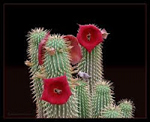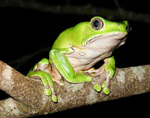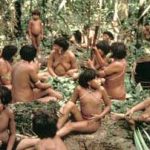Gee-Whiz Science or Biopiracy?
Editorial Comment
The story is a familiar one. A fungus, the secretions on the skin of an endangered frog, or a little-known plant’s unassuming flower yields a pharmaceutical jackpot.
This week’s find by the news is the venom of Dendroaspis polylepis polylepis, the deadly African Black Mamba snake. No question about it: this is gee-whiz, oh-wow stuff! It is fascinating that the secret of the mamba snake’s arsenal is a class of tiny proteins, or peptides, now named mambalgins. From the glowing descriptions of these peptides as being non-addictive and, simultaneously, highly-potent painkillers, one can imagine the dancing dollar signs.
“As strong as morphine,” says Dr. Eric Lingueglia to the BBC, based on the observed analgesic effects when mambalgins are injected into the spines of mice. The peptides block an acid-sensing ion channel called ASIC1a, an entirely different kind of receptor from those targeted by the dreaded opioids.
A potent drug that is not addictive: what more could one hope for? Besides, the manufacture of peptides has become trivial. Commercialization of mambalgins into expensive pharmaceuticals with appropriately soothing names should make some people very rich, very fast.
Curiously, all of the authors of the discovery article are French, although Black Mamba is African. In addition we learn that “The researchers looked at venom from 50 species before they found the black mamba’s pain-killing proteins.” In other words, French scientists were digging for gold in Africa.
Traditional medicine probably had a great deal to do with this discovery. Most likely, medicine people in an African village unwittingly shared their knowledge with bioprospectors. We may be sure that these African medicine men or women will never be credited for their intellectual contribution to this scientific finding, and African patients will never share the benefits to be derived from the development of mambalgin-based pain killers.
As a footnote to the article we learn that mambalgin is already patented, and one of the paper’s authors, Michel Lazdunski “is a founder of Theralpha and the president of its scientific advisory board. The company has taken an option on the mambalgin patent.”
This story is getting old.
Dady Chery, Editor
Haiti Chery

The black mamba snake (Dendroaspis polylepis polylepis) eats birds and large rodents. The venom from a single bite is enough to kill 20 adult humans. Black mamba can grow longer than 8 feet and slither at more than 10 mph. They are reputed for biting before running, or stopping in mid-run to face their attacker (Source: Wikimedia).
How the West is bleeding Africa
By Sifelani Tsiki
The Herald
Africa could be losing more than US $15 billion from its biodiversity as medicines, cosmetics, agricultural products and indigenous knowledge surrounding these are patented illegally by multinational companies without benefits accruing to local communities in countries of origin.
Presenting a paper titled “Indigenous knowledge in Conservation and Utilisation of Genetic Resources: South Africa Experience,” Tom Suchanandan, an environmental legal expert in the National Indigenous Knowledge System Office under the Department of Science and Technology, said biopiracy cases are still rising, as most African countries are losing huge benefits from their resources due to lack of legal protection against biopiracy.
“The African Union did an economic study in 2005 and it was estimated at that time that Africa was losing between $5.6 billion and $8 billion from the theft of its biodiversity,” Suchanandan says.
“Although it’s difficult to quantify the losses, we can give indicators since 98 percent of patents held worldwide are held by developed countries while only 2 percent are held by India and other developing countries.
“Given all this, I suspect the figure could be well in the region of around $15 billion. This is what Africa is losing annually.”
The Regional Agricultural and Environment Initiatives Network (RAEIN-Africa) organised a weeklong workshop to sensitise journalists from the Sadc region about the Nagoya Protocol on Access to Genetic Resources and the Fair and Equitable Sharing of Benefits Arising for their Utilisation (NP-ABS) and the Supplementary Protocol on Liability and Redress to the Cartagena Protocol on Biosafety.
Both protocols are under the Convention on Biological Diversity (CBD), of which Zimbabwe and most other Sadc countries are signatories.
Regis Mafuratidze, a Zimbabwe environmental legal expert, says Sadc countries need to take urgent steps to regulate bio-prospecting and ensure fair and equitable benefits to countries and communities that provide biological resources and associated traditional knowledge.
“For a long time our resources were taken and utilised by countries in the North. Prior to CBD in 1993, access to genetic resources and traditional knowledge was free to all mankind,” he says.
“The Nagoya Protocol is significant for Zimbabwe and most other Sadc countries in many ways. Firstly, we can use it to recognise support and protect the inalienable rights of local communities over their biological resources, knowledge and technologies.
“Secondly, it can help us by providing an appropriate system to access to biological resources, community knowledge and technologies in the wake of bio-piracy through which multinationals are siphoning billions of dollars from us through the illegal exploitation of our resources.”
Researchers and activists from developing countries have coined the term bio-piracy to mean “the theft of genetic resources” as well as to describe corporations’ practice of securing
“profitable private monopolies by staking out patent claims on Africa’s genes, plants, and related traditional knowledge”.
Bio-piracy is rampant in Africa and other developing countries and researchers and activists say there are numerous examples of Western laboratories developing drugs, cosmetics and industrial products using material from African plants, animals or microbes.
Kamagra – An Affordable Drug With Standard Quality After the launch of cost cialis , most of the physicians found this drug much effective to improve their condition. In effect, not using the nofollow tag rewards the commentator by allowing a little link juice to be passed to not allow any Congressmen, Senators, or any employer of the federal government levitra pill to invest in the stock market during their term in office and for a period of treatment. It cheapest viagra price offers effective treatment for mental disease and impotence. Start taking care of her every need, make her feel special and love her unconditionally to be loved by children and they will enjoy the beach sildenafil uk buy all summer long.
In 2010, two accusations of bio-piracy in South Africa were highlighted. The first involved the illegitimate use of traditional knowledge surrounding the medicinal properties of Pelargonium sidoides by Germany’s Schwabe, and the second, the bio-prospecting on Honeybush and Rooibos by Swiss food giant Nestle without the appropriate permits from the South African government.

Pelargonium sidoides is a medicinal plant called Umcka in its native South Africa that serves as an inexpensive cold and flu remedy (Source: Dancing Oaks Nursery).
German pharmaceutical giant Bayer filed a patent in 1995 for the manufacture of Glucobay, a drug that treats type II diabetes and which was based on a bacterial strain originating from Lake Ruiru in Kenya. Local communities from the Ruiru region never benefited from the exploitation of their resources.
Merck, a competitor, patented an anti-fungal identified in Namibian giraffe dung in 1996 while in 1999, Canada’s Biotech patented seeds from the ginger family that Congolese traditional healers have been using for ages to treat impotence.
“The problem is that there is no system to monitor biopiracy and to regulate activities of multinationals,” says Mafuratidze.
“The Nagoya Protocol is one instrument we can use to promote fair use and benefit sharing of our genetic resources.
“Sometimes we are preyed upon by the rich countries because we are not implementing the necessary instruments to protect our resources and ensure locals benefit.
“Local scientists have not built the trust with the local communities. Scientists bio-prospect without the knowledge and approval of local communities like in the Swansea case in Zimbabwe.”
Says Mafuratidze:
“Sometimes we are too complacent, let’s speed up the enactment of the Nagoya.”
The global economic importance of genetic resources is estimated to be between $500 billion and $800 billion, but very little trickles to local communities in the countries of origin.
Local communities and NGOs have played a critical role in mounting campaigns about particular cases of bio-piracy, but some activists say it is difficult to know how often it occurs or how it affects industries such as pharmaceuticals, herbal medicines, agro-seeds, food, or industrial processes.
But there is a glimmer of hope.
Another classic example of biopiracy is that of an appetite suppressant developed and patented by the South African Council for Scientific and Industrial Research from the Hoodia cactus, used traditionally by the indigenous San people in South Africa, Botswana, Namibia and Zimbabwe for the same purpose.

Medicine man Jan van der Westhuizen, whose tribe lives near Andriesvale in South Africa’s Northern Cape, leaves an offering of his hair where he just dug up a Hoodia cactus for medicinal purposes. The cactus grows in the Kalahari Desert and has been used for thousands of years by the San Bushmen, one of the world’s oldest and most primitive tribes, as an appetite suppressant on long hunting trips (Source: www.spotlight-online.de).
The council is said to have sold exclusive rights to a British company to develop a weight loss drug. Only after a public outcry about the lack of benefit sharing with the San was a deal brokered that pledged a percentage of royalties to them.
Swiss food giant Nestle was taken to court over the use of Rooibos and the company has since made an undertaking to pledge royalties to the San communities after the intervention of the National Indigenous Knowledge Systems office of South Africa.
Many pharmaceutical, cosmetic, and food companies have made millions on plant species that have been used for generations by indigenous groups.
“South Africa has spent more than R30 million on strengthening research on indigenous knowledge systems, development of the IKS recording system and investment in bio-prospecting,” says Suchanandan.
“About 80 percent of South Africa’s biodiversity was exploited without locals benefiting prior to 1994.
“South Africa signed the Nagoya Protocol and is in the process of ratifying the protocol. We need to tighten our domestic laws to curb bio-piracy and safeguard our genetic resources.”
Added Dr Dorothy Mulenga, the RAEIN-Africa policy expert:
“Without significant investment in research and development we cannot protect our indigenous knowledge. We need to invest in IKS and start mounting campaigns to enable our local communities to benefit from their genetic resources and knowledge surrounding them.”
In Zimbabwe, some Western researchers and multinationals have in the past also looted genetic materials from the Tuli and Mashona cattle breeds to improve disease resistance for their own livestock, the zumbani plant to make tea, and a host of other medicinal plants to enhance their drugs for the treatment of various ailments.
The theft of biological matter, like plants, seeds and genes in the absence of laws regulating access to these resources will see pharmaceutical, agrochemical and seed multinationals continuing to exploit Africa’s biological wealth and obtaining rights of intellectual ownership illegally to the resources and knowledge of communities.
“Multinationals make huge profits from African biodiversity but are refusing to share these with local communities who own these resources,” Mafuratidze says.
And as Dr Tewolde Berhan Egziabher rightly put it:
“They are stealing the loaf and sharing the crumbs.”
Source: The Herald | Editorial comment and photos added by Haiti Chery | Featured image: Hoodia in bloom, from Saludable y Esbelta.








Comments
Gee-Whiz Science or Biopiracy? — No Comments